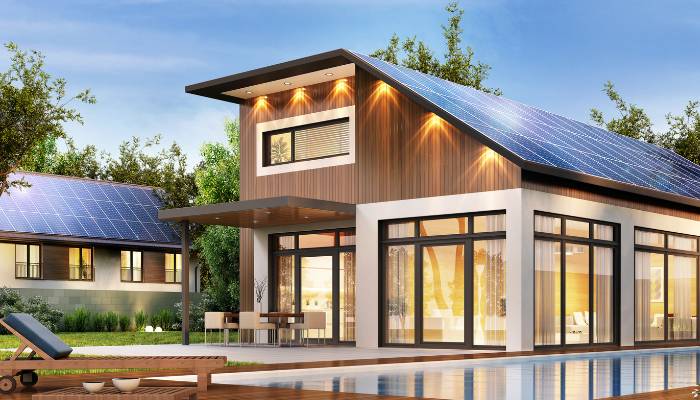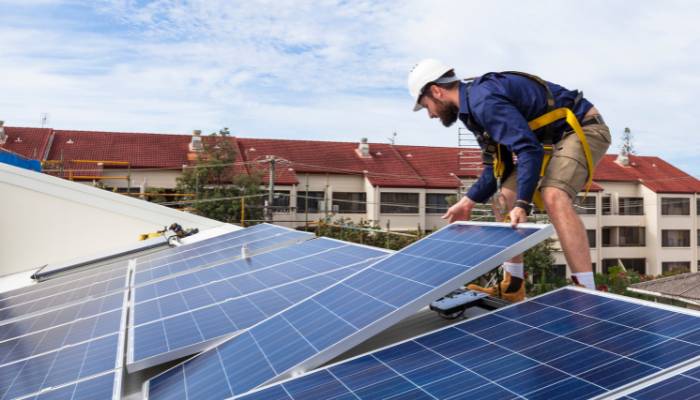
The concept of energy efficiency has become increasingly important over the years, and one way of achieving this is through the installation of solar panels on buildings. The integration of solar panels with tar and gravel roofing system is an innovative solution that combines the benefits of energy efficiency and durability. We explore here, aspects of tar and gravel roof with solar panels, the advantages of using the system, the benefits of solar panels, and how these two technologies can be integrated to provide energy-efficient roofing solutions.
Tar and Gravel Roofing System
Tar and gravel roofing, also known as built-up roofing, is a type of flat roofing system that has been used for many years. This roofing system is made up of several layers of materials, including a base layer of insulation, a layer of hot tar, and a layer of gravel or other aggregate material. The tar is heated to a high temperature and then poured onto the surface, providing a watertight seal that is resistant to the elements. The layer of gravel on top of the tar helps to protect the roof from damage caused by UV rays and other environmental factors.
The advantages of tar and gravel roofing system are numerous. First and foremost, it is incredibly durable and can last for up to 20-30 years with proper maintenance. It is also fire-resistant, which makes it a safer choice for commercial and residential buildings. Additionally, it is cost-effective, easy to repair and maintain, and provides good insulation, which helps to reduce heating and cooling costs.

Solar Panels
Solar panels are photovoltaic devices that convert sunlight into electricity. They are becoming increasingly popular as a renewable energy source for residential houses and commercial buildings. The benefits of solar panels are numerous. First, they help to reduce energy bills by generating electricity from sunlight, which is free and renewable. They also help to reduce greenhouse gas emissions, which is good for the environment. Additionally, solar panels can increase the value of a property and provide a source of backup power during power outages.
Integration of Solar Panels with Tar and Gravel Roofing System
The integration of solar panels[1] with tar and gravel roofing system is a logical step towards more sustainable and energy-efficient roofing solutions. Installing solar panels on tar and gravel roofs is relatively easy, and there are many benefits to doing so. First, the layer of gravel on top of the tar provides a stable and secure base for the solar panels. Additionally, the gravel helps to reflect sunlight, which can increase the efficiency of the solar panels. Finally, the installation of solar panels on tar and gravel roofs can help to extend the lifespan of the roof by protecting it from UV rays and other environmental factors.
However, there are some challenges associated with the integration of solar panels with tar and gravel roofing system. One of the biggest challenges is the weight of the solar panels. Solar panels are heavy, and the weight can put additional stress on the roof structure. Additionally, the installation of solar panels on tar and gravel roofs can be more challenging than on other roofing systems due to the need for additional support structures.
To overcome these challenges, it is important to work with experienced roofing and solar panel installation professionals. They can provide guidance on the best ways to install solar panels on tar and gravel roofs and ensure that the roof structure is strong enough to support the weight of the panels. Additionally, they can recommend appropriate support structures and ensure that the installation is done in compliance with local building codes and regulations.
Lifespan of Tar and Gravel Roof
Tar and gravel roofing, also known as built-up roofing, has been a popular roofing choice for many years due to its durability and longevity. When properly installed and maintained, a tar and gravel roof can last up to 20-30 years or even longer. However, the lifespan of a tar and gravel roof can be affected by several factors, including climate, maintenance, and installation quality.
Climate
Climate is one of the most important factors that can affect the lifespan of a tar and gravel roof. Extreme weather conditions, such as heavy rain, snow, and wind, can cause damage to the roof over time. Exposure to UV rays can also cause the roofing materials to deteriorate, leading to cracks, leaks, and other issues. In areas with harsh weather conditions, it is important to choose high-quality roofing materials that can withstand these conditions and ensure proper maintenance is performed to help prolong the lifespan of the roof.
Maintenance
Proper maintenance is crucial to ensuring the longevity of a tar and gravel roof. Regular inspections should be carried out to identify any potential issues, such as cracks or leaks, before they become serious problems. A maintenance program can help to ensure that the roof is free from debris, such as leaves and branches, that can trap moisture and cause damage to the roofing materials over time. Additionally, the roof should be cleaned periodically to remove any dirt or other debris that may accumulate on the surface.
Installation Quality
The quality of the installation can also have a significant impact on the longevity of a tar and gravel roof. Choosing a reputable roofing contractor with experience in installing tar and gravel roofs is important to ensure that the roof is properly installed and can withstand the elements. Proper installation includes ensuring that the layers of materials are applied correctly and heating the tar to the proper temperature to ensure a secure bond with the underlying layers, making the roof watertight.
Summary
To summarize, the integration of solar panels with tar and gravel roofing system is an innovative solution that provides numerous benefits. It combines the durability and cost-effectiveness of tar and gravel roofing with the energy efficiency of solar panels.

Welcome to MithilaConnect, where we curate the art of living, celebrating the vibrant tapestry of life through culture, fashion, food, and everything in between.
